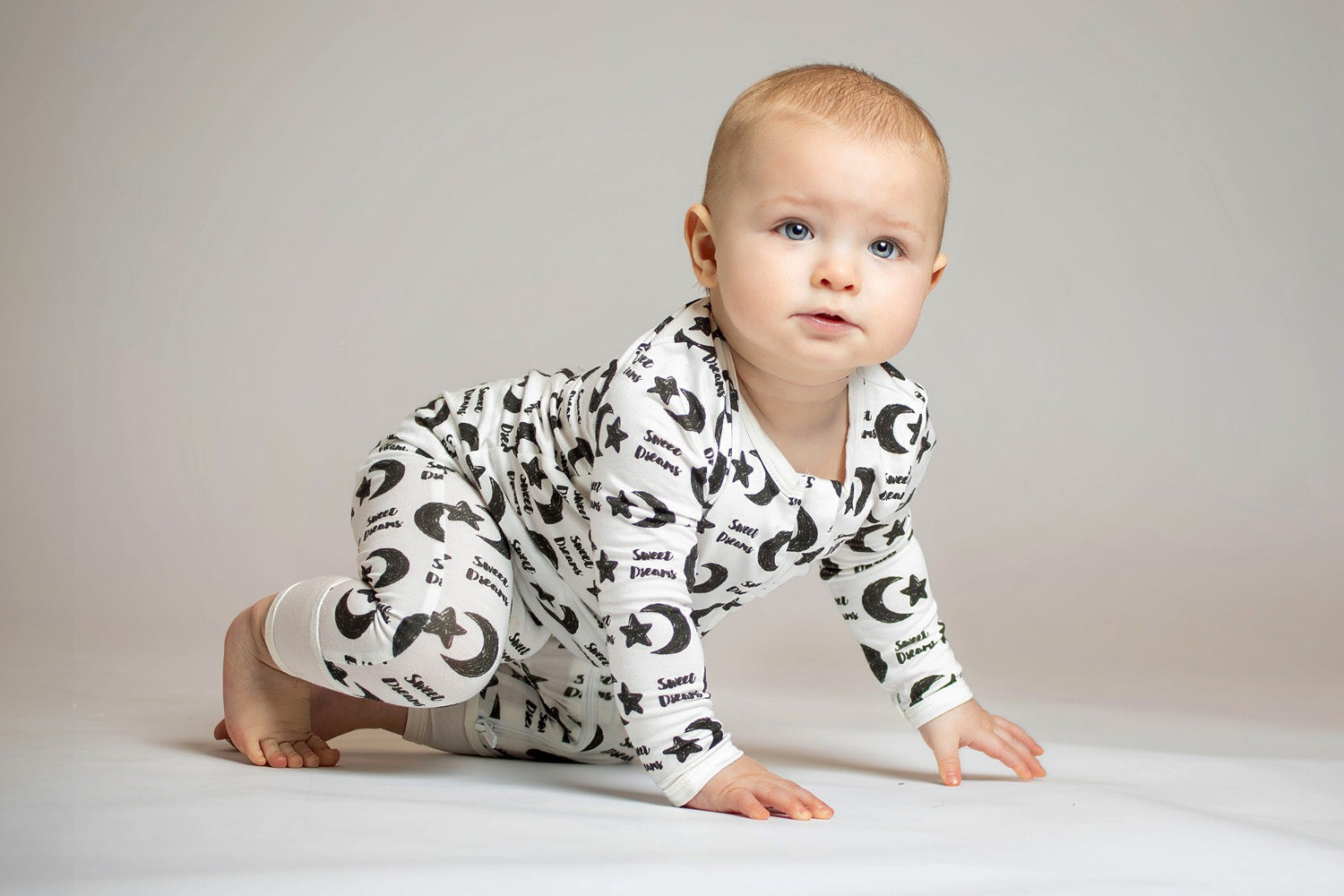Ensuring your baby sleeps safely and comfortably through the night is essential for their development and your peace of mind. The right environment, coupled with suitable clothing, plays a critical role in achieving this. Among the many options available today, bamboo baby pajamas and bedding stand out for their natural softness and breathability.
In this article, we’ll help you create the ideal sleep conditions for your baby, from room temperature to choosing the perfect baby wear, ensuring they are snug and secure throughout the night.
Understanding the Best Sleep Temperatures for Babies
Creating an optimal sleep environment for your baby starts with understanding the ideal room temperature. Pediatric experts generally recommend keeping the nursery at a comfortable 68-72 degrees Fahrenheit (20-22 degrees Celsius). This range provides a safe and cozy environment conducive to good sleep, but it’s crucial to note that individual needs can vary slightly depending on your baby’s health and preferences.
Guidelines for Adjusting Room Temperature
Maintaining the recommended temperature can sometimes be challenging, especially with seasonal changes and differing home climates. Here are some tips to manage the room temperature effectively:
- Use a Thermostat: Keep your baby’s room at a consistent temperature with a programmable thermostat. This device can automatically adjust the heating or cooling based on the time of day or night.
- Monitor the Temperature: Regularly check the temperature in your baby’s room with a reliable thermometer. Consider a digital thermometer that can provide alerts if the temperature goes above or below the desired range.
- Adjust Based on Seasons: In colder months, you may need to use a heater, but ensure it’s safe and doesn’t overheat the room. During warmer months, an air conditioner or fan can help keep the room cool, but be sure to keep air from blowing directly on the baby.
Maintaining this balance not only ensures comfort but significantly reduces risks associated with improper baby sleep conditions, such as overheating or catching colds from chilly temperatures. With these guidelines, you can help ensure your baby gets a restful night’s sleep in a well-regulated environment.
Choosing the Right Sleepwear
The choice of what your baby wears to bed significantly influences their comfort and safety throughout the night. When selecting baby sleepwear, the material and fit are important considerations.
Bamboo fabric is increasingly popular for baby wear due to its natural properties. It is exceptionally soft, making it gentle on your baby’s sensitive skin. Additionally, bamboo is highly breathable, ensuring adequate air circulation that helps regulate your baby’s body temperature. This prevents overheating, a common concern for many parents, while also keeping your baby warm and cozy.
Dressing Baby Based on Temperature
The way you dress your baby for sleep should reflect the climate and the room temperature. Here are some scenarios to help guide your choices:
- Warm Climates: In warmer areas, opt for a single layer of lightweight and breathable fabric. A short-sleeved bamboo bodysuit or pajamas can be ideal, allowing for airflow while absorbing any moisture, keeping your baby cool and dry.
- Cooler Climates: In cooler conditions, you might layer slightly more but remember the rule of thumb—your baby needs one more layer than you do to be comfortable. Start with a bamboo long-sleeve bodysuit and add a fleece sleep sack if needed. Sleep sacks allow for movement and warmth without the risks associated with loose blankets.
Layering Tips for Comfort and Safety
Layering is an effective way to ensure your baby is dressed appropriately for any sudden changes in temperature, especially during the night when you might not be monitoring the thermostat as closely. Here are some tips for safe and comfortable layering:
- Start with a Base Layer: A soft, breathable bamboo bodysuit can serve as an excellent base layer. It keeps moisture away from the skin and maintains a comfortable body temperature.
- Add Layers as Needed: Depending on the temperature, add layers such as a warmer top or a sleep sack. Remember, the sleep sack is preferable to blankets, which can pose safety risks.
- Avoid Overheating: Be mindful not to over-layer. Excessive warmth can be just as discomforting as the cold. Feel your baby’s neck or back to check if they are sweating or seem flushed, which are signs of overheating.
By choosing the right materials and using smart layering techniques, you can create a safe and comfortable sleeping environment for your baby, helping them—and you—enjoy a peaceful night’s sleep.
Signs of Discomfort to Watch For
Identifying signs of discomfort in your baby’s sleep can help you adjust their sleep environment and clothing to ensure they remain safe and comfortable. Recognizing these indicators is key to preventing any sleep disruptions or potential safety risks.
Key Indicators of Discomfort
- Too Hot: If your baby’s temperature is too warm, they might sweat excessively, exhibit flushed cheeks, have damp hair, or breathe rapidly. These signs indicate that their body is under heat stress and is trying to cool down. In such cases, reducing the room temperature, adjusting the fan, or removing a layer of clothing can help.
- Too Cold: A baby that is too cold may have cool skin, particularly at the extremities like hands and feet. They might also show signs of discomfort or disturbed sleep. Adding a layer, such as a wearable blanket or sleep sack, can provide additional warmth without the hazards associated with loose bedding.
What to Avoid in Baby Sleepwear
When dressing your baby for sleep, safety is as important as comfort. To ensure your baby remains safe throughout the night, consider the following precautions:
- Avoid Loose Clothing: Opt for well-fitting pajamas or a snug sleep sack. Loose clothing can ride up around your baby’s face, posing a risk of suffocation.
- No Hats or Beanies Indoors: While hats are great for outdoor protection, they are not advisable for indoor sleep as babies can overheat or, in some cases, the hat could slip down and cover their faces.
- Check for Hazardous Attachments: Ensure that the sleepwear does not have any loose ribbons, buttons, or hooks that could detach and pose a choking hazard.
Safe Sleep Practices
Importance of Back Sleeping and Clear Cribs
One of the most critical practices is placing your baby on their back for every sleep. This position has been shown to significantly reduce the risk of Sudden Infant Death Syndrome (SIDS). It ensures that the airways are less obstructed and helps in safer breathing.
Additionally, keeping the crib clear of loose items is imperative. Here’s what you should consider:
- Keep the Baby’s Crib Bare: Aside from a firm mattress and a fitted sheet, avoid placing pillows, stuffed toys, or blankets in the crib. These can increase the risk of suffocation or entanglement.
- Use Wearable Blankets: Instead of traditional blankets, opt for a sleep sack. This wearable blanket ensures your baby stays warm without the risks associated with loose bedding. It’s designed to stay in place and provides comfort without compromising safety.
Following these practices can provide a safe sleep environment for your baby, significantly reducing the risks associated with sleep-related accidents and increasing your peace of mind.
Also read: Newborn Sleep Schedule: The Perfect Baby Sleep Routine
Earthly Threads: Your Baby’s Sleep Partner
Remember that choosing the right sleepwear and creating a safe sleeping environment are integral to your baby’s health and safety. Bamboo pajamas and premium bamboo sheets from Earthly Threads offer a perfect blend of comfort, safety, and eco-friendliness, helping your baby sleep better and safer. Their natural breathability and softness ensure your little one stays comfortable throughout the night, making Earthly Threads your ideal partner in fostering serene and safe sleep for your baby.
FAQs on How to Dress Baby for Sleep
Parents often have numerous questions about the best practices for dressing their babies for sleep. Here are answers to some of the most common queries, incorporating expert opinions and research:
How many layers of clothing should my baby wear at night?
Typically, your baby should wear one more layer than what an adult would comfortably wear under similar conditions. A good rule of thumb is to dress them in a base layer, like a bamboo bodysuit, and then add a sleep sack for additional warmth if necessary.
Can my baby sleep in a cap or hat?
It is best to avoid hats and caps when your baby is indoors, especially in their sleep environment. Babies primarily regulate their body temperature through their heads and faces, and wearing a hat indoors can lead to overheating.
How do I know if my baby is too hot or too cold?
Regularly feel your baby’s neck, back, or tummy to check their temperature. If these areas feel sweaty or very warm, your baby might be too hot. Conversely, if these areas feel cool to the touch, consider adding another layer, like a sleep sack.
Is it safe to use blankets for my baby during sleep?
It is safer to avoid loose blankets in the crib. Opt for a sleep sack as it provides the necessary warmth without the risks associated with traditional blankets.


